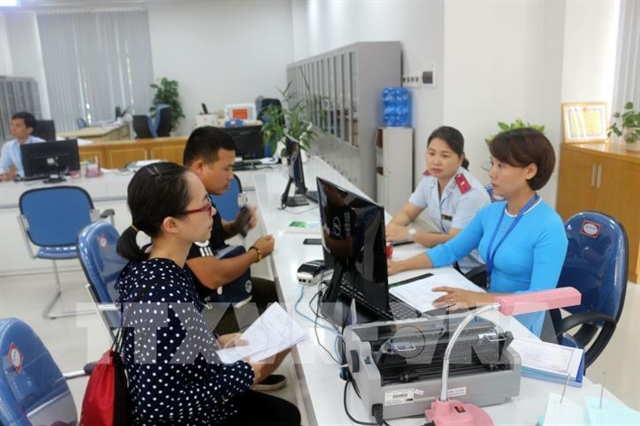 Politics & Law
Politics & Law


|
| People apply for services at the Public Administration Services Centre in the northeastern province of Quảng Ninh. — VNA/VNS Photo Đức Hiếu |
HÀ NỘI — The northeastern province of Quảng Ninh maintained its first position on the Public Administration Reform Index (PAR Index) for the third consecutive year in 2019.
The province also topped the Satisfaction Index of Public Administration Services (SIPAS) which measures the quality of public service delivery through feedback from citizens and organisations.
The results were announced on Tuesday by the Government’s Steering Committee on Public Administration Reform. Deputy Prime Minister Trương Hoà Bình, head of the committee, chaired the announcement online.
The PAR Index 2019 looked at 17 ministries and ministerial agencies excluding the Public Security Ministry and Government Office.
Public administration reforms at the Committee on Ethnic Minority Affairs and the Government Inspectorate were also assessed but not rated together with the other ministries and agencies.
The SIPAS was measured at provincial/municipal People’s Committees in all 63 provinces and cities in the country.
Ministries, agencies, cities and provinces self-assessed their performances in public administration reform. About 20,000 State officials, employees at ministries and localities and over 33,000 citizens and representatives of organisations gave their feedback for the survey.
Quảng Ninh Province's PAR Index of 90.09 per cent led 63 localities nationwide. Hà Nội scored 84.64 per cent while Đồng Tháp recorded 84.43 per cent to make up the top three.
The southern province of Bến Tre ranked bottom of the index with 73.87 per cent due to ongoing issues such as failing to fulfill the Prime Minister’s assignments, slow tackling of unlawful documents, and not publicising new administrative procedures as regulated.
According to the Ministry of Home Affairs which produced the PAR Index, the average index across the country in 2019 was 81.15 per cent, the highest rate in the last four year.
The gap between the two provinces at the top and bottom positions narrowed and 62 provinces and cities improved compared to the results from 2018.
Provinces in the Red River Delta and southeastern provinces had an average index of 82.95 per cent and 82.02 per cent, respectively, higher than those in other parts of the country.
Among the 17 ministries and agencies ranked in the PAR Index 2019, the State Bank of Việt Nam led with an index of 95.4 per cent. This is the 5th time the credit institution has earned first position on public administration reform.
The Ministry of Finance was ranked second with an index of 94.77 per cent, while the Ministry of Justice ranked third on 90.12 per cent.
The Ministry of Transport was last for the second consecutive year with 80.53 per cent in 2019 following the 75.13 per cent it scored in 2018.
Deputy Governor of the State Bank of Việt Nam (SBV) Đào Minh Tú said that SBV had focused on six areas to improve administration reform including institutional reforms with new/amended regulations on managing borrowing activities at credit institutions, simplified administrative procedures, and improved access to loans for citizens and business.
Tú said the SBV would continue to improve relevant legal frameworks, apply advanced information technology and increase human resource quality.
Public satisfaction
The Satisfaction Index of Public Administration Services (SIPAS) 2019 was developed with feedback from nearly 36,300 people regarding public service delivery quality in provinces, districts and communes regarding 16 public services such as granting/licensing/certificating land-use rights, the environment, driving licences, transport, construction, legal assistance, business licences, labour and social welfare.
Quảng Ninh, Hải Phòng and Cà Mau were named top of the SIPAS 2019, while Bình Thuận, Đắk Lắk and Cao Bằng were bottom.
Minister of Home Affairs Lê Vĩnh Tân told Vietnam News Agency that measuring the satisfaction of public service users – citizens and organisations – helped the Government and particularly public administration service providers see their achievements and shortcomings.
It also found what citizens and organisations expected from service delivery quality so they could adjust to meet their expectations, Tân said.
“Measuring citizens’ satisfaction also pushes State employees and civil servants to be aware of and form a working culture in which service users are at the centre and providers are there to meet users’ expectations,” Tân said.
Efforts made by the Government, ministries, agencies and localities in public administration reform were recognised by citizens and organisations, Tân said, adding that the biggest recognition was increased trust in the Government.
“It is important that after looking at public feedback, the Government creates more favourable conditions for people to access better public services that require less time and money,” he said. VNS




